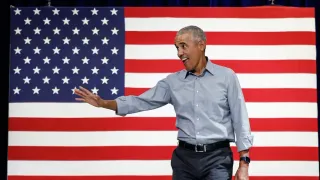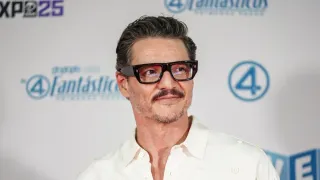October 22, 2016
Graphic Novel 'The Case of Alan Turing' Sheds Light on Real Life Gay Hero
Andy Smith READ TIME: 11 MIN.
The work of English mathematician Alan Turing lead directly to the development of the computer, while his genius for breaking seemingly impenetrable Nazi codes saved millions of lives during World War II.
Turing's success was rewarded with chemical castration (estrogen injections) after a conviction for "gross indecency" in the early 1950s. In 2012, detailed records of his work cracking the Nazi Enigma codes were released to the public for the first time. Queen Elizabeth II granted him a posthumous pardon in 2013.
The subject of multiple documentaries, a TV miniseries and the Oscar-nominated "The Imitation Game," Turing's story has now been turned into the graphic novel "The Case of Alan Turing: The Extraordinary and Tragic Story of the Legendary Codebreaker."
Drawing from facts of his life and using imagination to recreate Turing's inner life, the book focuses on the intensity of his work, his largely repressed homosexuality and the inspiration he drew from the most important personal relationship in his life - his love for schoolboy friend Christopher Morcom, who died in his early teens.
An interview with the creators Arnaud Delalande (text) and Eric Liberge (illustrations) follows, with assistance from the staff at Arsenal Pulp Press and Beth Parker from Beth Parker PR, who helped the French-speaking artists with translation.
EDGE: Arnaud and Eric, how did you come together to collaborate on this graphic novel? Had you worked together before or known each other's work? What made you want work together?
Arnaud Delalande: Actually, we didn't knew [sic] each other, and we had never worked together! It was Laurent Muller, our French publisher at the "Ar�nes," who had the idea to create the team. I had worked with Laurent as a scriptwriter on many graphic novels in France ("Le Dernier cathare," "Surcouf," "Codex Sina�ticus"), and Laurent admired Eric's work, especially on "Wotan" or 'Mardi-Gras Descendres." When Laurent told me that he thought of Eric for the art, I rushed to his work, and the next day I called Laurent back and said: "I love this, it would be great!" Eric and I met a bit later, and I think we both knew instantly that this team would work. We had the same references and we were speaking the same language. We agreed very soon on the artistic orientation we wanted for this project.
Eric Liberge: This is a project that I typically label "fallen from the skies." In September 2015, Laurent emailed me the script from Arnaud, whose historical comic book work I knew already - but we had not had the opportunity to meet each other yet. So I read Arnaud's script and found it very interesting to transpose into a graphic novel. The thing is, I didn't know anything about Alan Turing at the time, so curiosity about this biopic was also a driving force to accept the project.
Moreover, most of the action in this story takes place during World War II, which is a period I had already been working on for another comic book, "Wotan," in which I composed the story as well as the art. So I had a fresh and huge documentation on this period (except on the British side of it - Bletchley Park, etc.) I also liked the direction of Arnaud's biopic very much; that is to say, the more intimate and somewhat oneiric Alan Turing, easier for us to speak of his repressed homosexuality.
EDGE: Arnaud: When did you first become interested in Alan Turing - was it when the specifics of his codebreaking work were declassified in 2012, or earlier? Were you more drawn to his tragic personal story or his groundbreaking work?
Arnaud Delalande:: To be honest, I didn't know much about Alan Turing until my publisher told me of him! It was a bit after the specifics of his codebreaking work were declassified, and moreover after the Queen's rehabilitation of Turing's memory in 2013. Laurent Muller gave me two different biographies of Turing and told me, "You should have a look."
I read both and found immediately the subject fantastic. There was everything in this story: A world war; the personal scientific challenges of a man trying to break an unbreakable code with incredible background issues; an intimate struggle because of his homosexuality in a Puritan society; the tragic destiny of a secret, lonely but national hero. So I was drawn by the intimate story as much as I was by the global implications of Turing's fight against the Enigma machine - and the subsequent discovery of artificial intelligence! It was precisely the beauty and the power of this subject: these two intricate dimensions, the global one and the individual, introspective one.
There obviously was a room for an intense graphic novel. I also told Laurent from the start: "It would make a great movie!" And I didn't know, at this time, that the movie was already in progress!
EDGE: Eric: You've created history-based works, including a book on World War II. Was your interest in Alan Turing's work connected to that interest?
Eric Liberge: Yes, for sure, I would consider it a continuity of what I explored in Wotan, which is violence in a wartime period. I also like to draw the eras of the '30s to '40s. Beautiful men and women's costumes, dramatic atmospheres, etc.
This was when my parents were children, so I feel very much connected to it. Besides, the interest to get to know who Alan Turing was, the "father of computers" - this would be strong enough to make me want to do the book.
EDGE: Eric and Arnaud: Were there any aspects of "The Imitation Game" or other Turing bios or documentaries that you wanted to correct or that you thought misrepresented him as a scientist or as a man?
Eric Liberge: Well, for every biopic work, the most important thing to me is not to worry too much about what has been made before on the subject, because those films, books and documentaries have been made by other people - and are things we cannot erase, even if it does not fit to the idea we have of the Alan Turing we are trying to develop. And in fact, this is really what happens: We become intimate with the character that we are trying to bring back to life. So the Alan that I draw is my perception of the public person he was - certainly not the very truth, but a close version of him, I hope, which also enables me to bring in my universe and express myself. This is a perpetual balance between historical accuracy and artistic freedom.
Arnaud Delalande: "To correct" may be a little presumptuous! But yes, our personal opinion was that the literary biographies, as fascinating as they were, didn't catch the whole potential of this subject from a narrative, epic and dramatic point of view.
We also watched the TV British movie "Breaking the Code" with Derek Jacobi, an adaptation of Hugh Whitemore's play. Jacobi is great, but he seems very far from the real age of Turing at the time of the facts!
I was halfway through the writing of the script when "The Imitation Game" was released, so we were a bit anxious, of course - and then the movie won an Oscar! But despite this, we were somewhat relieved, because the film was really very different from our treatment. We both liked it, but we found it very "made in Hollywood," you know. And yes, there were numerous (voluntary) mistakes in the movie: for instance, the relationship with [Turing's one-time fianc�e] Joan Clarke is true, but a bit overestimated and treated in a Hollywood way; she wasn't recruited, as it is shown in the movie: she already worked in Bletchley Park as an administrative employee.
At the opposite, the homosexual dimension is very attenuated; the chronology is often wrong; the machine was never called "Christopher" by Turing; the letter to Churchill is not at the beginning of the story, but much further in the process, etc. We were even surprised that many details that we found however extraordinary (like the apple, the details of the presumed suicide, "Snow White," etc.), even a bit controversial, would not be treated at all in the movie.
We really had something new to say - as in, we had something to add, something different from the movie: Another point of view on the character, with a more introspective approach. At least, that was our intention!
EDGE: While researching "The Case of Alan Turing," what were some of the interesting, little-known aspects of his life and character you discovered?
Eric Liberge: I would say, all that concerns his repressed homosexuality and autistic behavior - these parts were the playground, so to say, where Arnaud and I would try to display Turing's emotional secret life to the reader, and make the people appreciate this very particular man he was.
Arnaud Delalande: There are a few. For example, in the movie Turing almost appears as an autistic person and crazy scientist. Benedict Cumberbatch is a great actor, and it is true that Alan had his own world - that he was eccentric, insolent, a rebel to authority, which is not so good when you work with the MI6 - and that he often was lonely. But he also worked with many people in Bletchley Park, he shared information, and had a real sense of humor. He worked as a companion, a teammate. Most of all, he was a great athlete! He really could have run in the Olympics, even in the late '40s, before his chemical treatment! There are many details like this that you will discover in the book.
EDGE: Is the book 100 percent fact-based, or did you take creative license in places?
Arnaud Delalande: We could say that yes, it is 100 percent fact-based, but the creative license appears, as you noticed, in the choice of a non-sequential type of narration, with many flashbacks and flash-forwards to paint the character's evolution. Or the choice of a certain graphic point of view, emphasizing Alan's inner pictures, metaphors or projections, which are sometimes a bit surrealist, sometimes expressionist or, on the contrary, impressionist. We looked for a graphic and poetic way to express his doubts, his scientific researches, his dreams, his fears. We worked a lot on that.
EDGE: Was Turing in fact fascinated by "Snow White?" Did he write about this interest in any of his journals?
Arnaud Delalande: He was not the only one to be fascinated by "Snow White," but it is true that the film moved him deeply. It came out before World War II, in 1937, and Turing was not yet working for the secret service. As the first color-animated feature-length, "Snow White" was in itself a revolution.
Turing was not very interested in cinema, he never went to the movies, but he went to see "Snow White" with a few friends - and he was profoundly astonished by this artistic and technical performance. Was it a form of precognition, a sense of destiny, of fate?
The moment where the witch gives the lethal apple to Snow White made an unforgettable impression on Alan, and we can't help linking this fact to the circumstances of his death 17 years later, with a poisoned apple. Of course, the apple is also a symbol of transgression, taboo, science and knowledge - and the bitten apple is the logo of a very well-known firm! Even if Apple's founders denied a direct link to these episodes of Turing's life, there is an amazing "cloud of connections" between all this: The fruit, Eve in heaven, Newton's apple, Alan's life and death, Snow White and the witch, the gift of science and artificial intelligence, from Enigma to our modern computers. I really tried with Eric to suggest in the book this fascinating and almost poetic continuum.
EDGE: Eric: Tell me about the visual images, especially the dreams and background images. (I think I noticed a robot from "Metropolis.") What was your inspiration? Lots of browns, grays, deep blues - does this reflect England in wartime (or am I just reading that into it)?
Eric Liberge: That's true! I tried to match my color palette to the old photographs of the WWII period. In fact, for every comic book I make, there is a defined palette of specific colors attached to it, as most of my work is based on atmosphere. This goes together with expressionist references, such as Fritz Lang and his "Metropolis." Moreover, there are also dream sequences of Turing showing saturated, warm colors, which fit to his fantasies and erotic dreams.
EDGE: Eric and Arnaud: In this collaborative process, how much input does Arnaud have in Eric's images? Is he largely hands-off or more actively involved in the process? Does Arnaud say, "I really want to include an image of an atomic explosion in the courtroom scene" or make similar requests?
Eric Liberge: Arnaud's script is fairly detailed, so I did not have to figure out too much. I followed his page-to-page scenario, which indicates time, location, number of characters, etc. Now, sometimes I had some suggestions to push a scene further, and we discussed it. In fact, I do not restrain myself to propose anything I feel that would fit in the story.
Arnaud Delalande: That was part of the pleasure. We had a real exchange on the script. I see novels or scriptwriting as a work on our "inner bombs," you know: a script is here to provide, create images. The more powerful the suggestion is, the best [sic] is the book. With Eric, I didn't have to push the button very hard! He has a great imagination.
EDGE: Arnaud: The non-sequential storytelling works well. Was it your first choice, or did you start with a more straightforward narrative?
Arnaud Delalande: I was confident early on what would be the key to our storyline. The idea was: "Yes, Alan Turing wants to break the Enigma code; but in doing this, he's trying to break the code of his own 'intimate' enigma. He is an enigma to himself, and to other people." So there is an inner and intimate quest running parallel to a great scientific and historical thriller. Since the beginning, I wanted to break the traditional straightforward narrative - I was really afraid of the "academic biopic" trap - to emphasize an introspective, non-sequential, almost dreamlike storytelling.
We wanted, with all the possible humility, to try to go "inside" the thoughts and feelings of Turing, with a very introspective approach. This led us from the start to a non-sequential approach. Then our treatment was an artistic interpretation of course, as always - but based on facts, documents, with serious historical research.
EDGE: Eric and Arnaud: Did either of you have an interest in cryptography, steganography or the encryption process before working on this project?
Eric Liberge: Well, I am not much of a mathematician myself, so my knowledge of these topics was very poor before Alan Turing. It was for me the opportunity to learn a lot.
Arnaud Delalande: I'll tell you what: In school, I was very, very bad at mathematics! Today I'm still not great, but I am also fascinated - as a writer - by scientific research. And I was really interested in cryptography, but as an amateur! So like Eric, this was an opportunity to learn. And it also was a sort of asset: we had to popularize Alan Turing's work for a most nonscientific audience. I can tell you it wasn't always easy - because of the complexity of the mathematics issues and the tragic circumstances of World War II - but it was definitely part of the challenge!
David Homel's English translation of "The Case of Alan Turing: The Extraordinary and Tragic Story of the Legendary Codebreaker" is available now.






